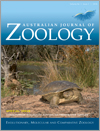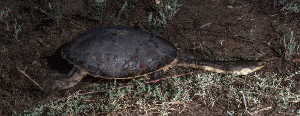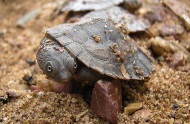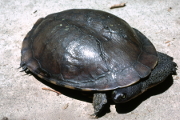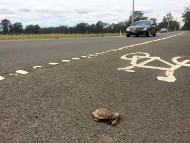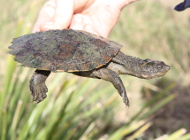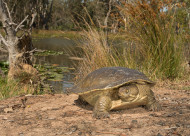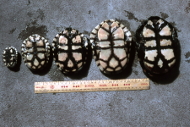Australian Journal of Zoology
Volume 66
Number 1 2018
Special Issue
Conservation Biology of Australian Freshwater Turtles
Globally, turtles are among the most threatened vertebrate taxa, with over 60% of all species being listed as endangered, threatened, or vulnerable. This special issue of the Journal contains a selection of papers from a conference on freshwater turtle conservation held in Canberra, ACT, in February 2017.
Chelodina expansa is an endangered turtle threatened by invasive red fox depredation on nests. Our study identified environmental variables associated with nest site preferences in C. expansa, including elevation above water, ground cover and vegetation. It allows the identification of nesting habitat that can be targeted for conservation management.
Photo by Jeremy Pike.
The Mary River turtle has endured long-term recruitment failure due to multiple impacts across its life-history and is protected under various legislation. This study investigated the nesting behaviour of Elusor macrurus, including the environmental drivers that affect nest inundation. Results will inform the development and assessment of e-flow strategies for nesting of E. macrurus in terms of current, and future water resource development.
Photo by Marilyn Connell.
Open flow respirometry was used to quantify the influence of sand type and cohort size on the energetic cost of digging in freshwater hatchlings. For a fixed cohort size, hatchlings spent more energy digging through coarse sand than fine sand, and on a per individual basis, larger cohorts spent less energy while digging in both coarse and fine sand.
Delayed nest emergence of freshwater turtle hatchlings is considered an adaptation whereby hatchlings enter the aquatic environment at the best time for survival and growth. However, delayed emergence in a population of the Australian turtle, Chelodina longicollis, appeared to be mainly due to imprisonment in the nest by hard soil.
Photo by Bruce Chessman.
We used data collected through the citizen science project TurtleSAT to describe the patterns of road mortality of freshwater turtles along the Murray River. The long-necked turtle (Chelodina longicollis) was the species most commonly reported dead on roads. We discovered a relationship between the likelihood of C. longicollis road mortality, rainfall and time of year. We also observed that dual carriageways such as the Hume Highway were the most likely locations where C. longicollis could be killed.
Photo by Claudia Santori.
Freshwater turtle populations can be jeopardised by the negative effects of roads. However, roads also represent a powerful sampling tool for a variety of data, and should be used for conducting environmental assessments, ecological research, and informing conservation. Our article tests and discusses best practices for conducting turtle road surveys.
Construction of Wyaralong Dam in South East Queensland was predicted to impact resident freshwater turtle species and their habitat. The relative abundance of the Macquarie River turtle (Emydura macquarii macquarii) and the common sawshell turtle (Myuchelys latisternum) was monitored during the dam’s first five years of operation. Results indicate that spatial and temporal variability in the relative abundance of the two turtle species occurred during the study but not all expected impacts were realised.
Photo by Seqwater.
We used environmental sampling and stomach flushing to determine how turtle diets varied with environmental conditions at four wetlands in north-central Victoria. Our results show in particular that Emydura macquarii select filamentous green algae (FGA) as a food source. We suggest that FGA scarcity may be limiting to E. macquarii.
Photo by Jules Farquhar.
For southern Chelodina longicollis, juvenile growth is rapid and similar among individuals, but adult growth is usually slow, erratic over time and varied among individuals. Asymptotic body length is variable for both sexes. Growth models suggest that sexual maturity occurs at 10 years in males and 16 years in females.
Photo by Bruce Chessman.


